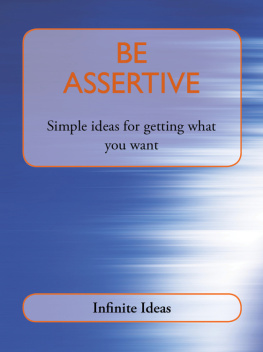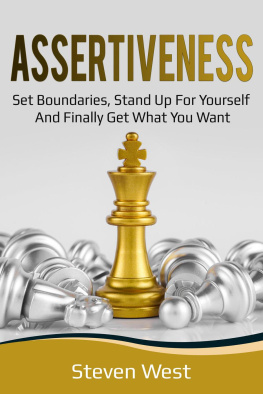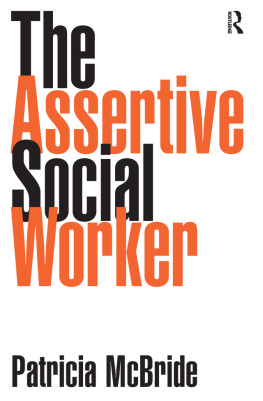How to Speak Your Mind Become Assertive and SetLimits
Darlene Lancer
2012, 2014 Darlene Lancer, JD, LMFT
Smashwords Edition
All rights reserved. No part of thispublication may be reproduced, stored in a retrieval system ortransmitted by any means electronic, mechanical, photographic(photocopying), recording, or otherwise without prior permissionin writing from the author.
The information in this book is intended tobe educational and not for diagnosis, prescription, or treatment ofany mental health disorder. Without a personal, individual,professional consultation with you, the author is unable to giveyou professional psychological advice. Hence, you understand thatthe material contained herein is general in nature, and the authordisclaims any personal liability, directly or indirectly forsuggestions and information in this book.
Smashwords Edition
Printed in the United States of America
Learn more at www.darlenelancer.com and www.whatiscodependency.com .
Table of Contents
Establishing Boundaries
Whats Your Bottom Line?
Setting Limits
Get Support
About the Author
How to Speak Your Mind Become Assertiveand Set Limits
Communication is so important that it canmake or break a relationship and is critical to success. Itinstantly reflects your self-esteem to listeners for better orfor worse. Speaking your mind with assertive communication commandsrespect, projects confidence, and inspires influence.
Communication is learned. With practice, youcan learn to communicate assertively, which will raise yourself-esteem and self-assurance and improve your relationships andprofessional performance.
What is Assertive Communication?
____________________________________________________________________________
What isAssertive Communication?
Assertive communication is respectful,direct, honest, open, non-threatening, and non-defensive. Itsneither passive, nor aggressive, and isnt passive-aggressive.Consider your communication style. Do you usually go along withothers and not communicate your opinions or true feelings? Are youthe oppositedemanding, aggressive, or manipulativeand try to getyour way? If youre passive-aggressive, you may appease someone andthen complain about him or her to another person, show up late, ortry to get your way indirectly.
Assertive communication respects theboundaries between you and someone else. It conveys your thoughts,feelings, needs, and experience to someone, including your responseto their statements and behavior. A response is different than areaction, which isnt assertive. When you react, you put the otherperson in charge of your self-esteem. Youre reacting to whatsgoing on inside of that person, instead of whats going on insideof you. A response, however, considers your feelings and thoughtsabout yourself in response to the other person. It may also includesilence, when appropriate. (Note, however, that silence can also bean automatic fear reaction, if youre afraid to speak up, which isnonassertive.).
When you arent assertive, its usuallybecause:
You want to spare someones feelings.
You want to avert conflict.
You want to be liked and avoid judgment orcriticism.
Youre afraid of making a mistake.
You dont want to impose or burdensomeone.
You dont want to jeopardize arelationship.
You dont want to spend the time.
The last reason may seem obvious on thesurface. Imagine youre at a party and someone asks you a personalquestion, which you dont want to get into then and there. Youmight avoid the question in many ways, including ignoring it,changing the subject, or walking away to get a drink refill. Youmight think the reason is to because you dont want to take thetime, but ask yourself why you wouldnt directly say, I prefer notto talk about that now (or here), or, I dont know you wellenough to discuss that. If you think the real answer is to sparetheir feelings, think again. The foregoing assertive answers areless hurtful than impolite behavior.
Why be Assertive?
____________________________________________________________________________
Why beAssertive?
Assertiveness prevents you from being eithera doormat or a bully. When youre passive and not assertive, youtry to avoid conflict and keep your thoughts and feelings inside,which leads to stress and rumination. The consequence of nothonoring your feelings, desires, and opinions is that those ofother people take precedence over your own. People learn that theycan get their way and that your feelings, desires, and needs dontmatter. Some people will take advantage of you. Your resentment,anger, and the desire for revenge can build, and even lead tophysical symptoms and illness. For example, if you always go alongwith what your spouse wants in order to avoid conflict, thisbecomes a pattern and also your spouses expectation. Meanwhile,you may consciously or unconsciously have negative feelings towardsyour partner and avoid closeness, which compiles your problems.
If youre aggressive, you may get your way,but make it unsafe for others to be close to you. Aggressivenessalienates people and undermines trust and friendships. In the aboveexample, if one spouse is bossy, you can see how the passive spousewill avoid conflict and pull away emotionally. Neither style allowsfor intimacy.
Assertiveness enables trust to develop inyour relationships, which thereby deepen. Close relationships arebuilt upon openness, trust, and authenticity. Whether in theworkplace or with friends and loved ones, when youre assertive,people learn that they can rely on you to tell the truth, even ifits negative. They know where you stand, and more importantly,where they stand with you. It allows for compromise and win-winnegotiations, so that both you and the other person can get yourneeds met.
Assertiveness improves your confidence andgreatly increases your self-esteem. It also enhances your jobsatisfaction and performance and earns you the respect of others,because it elevates their perception of your confidence andabilit
NonverbalCommunication
____________________________________________________________________________
Nonverbal Communication
Communication has many elements. Youcommunicate with more than your words. It is said that 70 percentof communication is nonverbal. Usually, your nonverbalcommunication is done unconsciously, so you may want to startpaying attention to it. You relay information with your entire bodythrough:
1. Gesture
Gesturing with your hands can reveal intentand emotion. Sometimes, gestures are used to emphasize what youresaying, but other gestures may contradict or distract from yourwords. Covering your mouth can indicate embarrassment. Claspingyour hands or fidgeting reveal nervousness. Crossing your armsshows the person youre speaking to that youre guarded, angry, orafraid.
2. Eye contact, movement, moisture, expression, andfocus
Eye contact and expression can vary frombeing an intimate and loving gaze to a threatening stare. Lack ofeye contact and focus can convey various meanings, such as guilt,shyness, evasiveness, or preoccupation. Moist eyes and tearscommunicate vulnerability and emotion, including love, sadness,regret, and shame.
3. Posture
New research has confirmed common experience that how you carry yourself imparts more than you knowwhether ornot intended. It reveals your personality and character. In thestudy, people were able to accurately identify nine out of tentraits merely by viewing the appearance of strangers.
Your posture indicates introversion orextroversion, high or low energy, confidence or submissiveness andshame. It can determine whether people think youre open and warmor closed and guarded, and whether youre likeable, in which case,they respond sympathetically. When youre interviewing for a job,sloppy posture can signal that youre careless and have low energyand low self-esteem.












